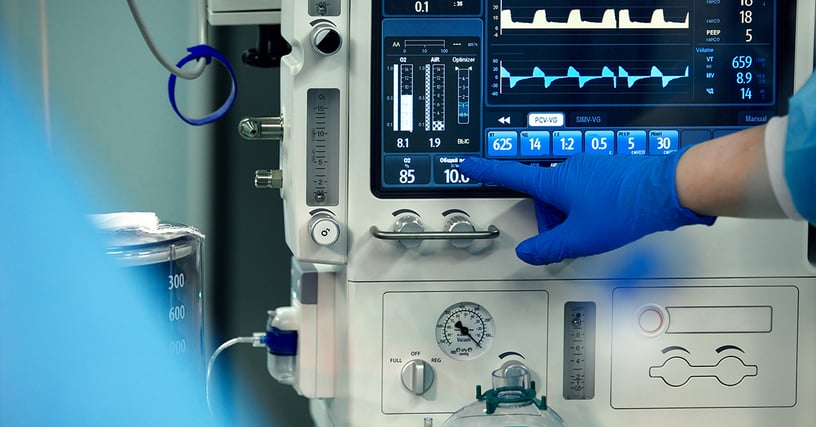Legacy systems can’t keep up with MedTech’s fast, fragmented, and high-stakes supply chain. It’s time to move from resilience to precision, control, and agility.

When “Good Enough” No Longer Is: The MedTech Supply Chain Crossroads
From unpredictable patient demand to rising product complexity, the traditional medical technology (MedTech) supply chain model is stretched to its limits. What was once built for consistency is now buckling under the pressure of fragmentation, hyper-specialization, and the demands of speed to market.
Today’s MedTech leaders are delivering more customized solutions to more diverse geographies across more channels than ever before. Yet, 70% of manufacturers say they still rely heavily on manual tools for key supply chain processes. That’s not just outdated, it’s unsustainable.
The current system is reactive, opaque, and siloed. What’s needed is an intelligent, adaptive model that brings agility, compliance, and precision into the core of supply chain execution.
The Disruption Loop: Why MedTech Supply Chains Keep Stalling
While the industry discusses digital transformation, many supply chains remain rooted in outdated foundations. Here’s what’s dragging them down:
- Unpredictable, High-Impact Disruptions From geopolitical shifts and port congestion to evolving health policy and raw material shortages, MedTech supply chains face more external volatility than ever. More than 80% of firms cite unplanned downtime and supplier constraints as top risks.
- Fragmented Global Operations A single MedTech device can involve 30 or more suppliers across multiple geographies. Without unified visibility, coordination becomes a guessing game and delays become inevitable.
- Escalating Product Complexity As devices become more personalized, modular, and tech-integrated, the pressure on supply planning and fulfillment is intensifying.
What’s Changing: The New Mandates of Modern MedTech Supply Chains
MedTech is undergoing a structural evolution. These three shifts are forcing companies to rewire how supply chains operate:
- Precision as the New Currency It’s no longer enough to be resilient. Companies must predict demand and orchestrate fulfillment with precision, down to the individual market, SKU, and patient level.
- Patient-Centric, Not Just Product-Centric The rise of home diagnostics, personalized therapies, and omnichannel care means MedTech supply chains must become responsive to patient-level needs, not just batch production volumes.
- Regulatory Pressure Meets Real-Time Expectations Traditional compliance models are document-heavy and audit-driven that can’t keep pace. Real-time data, traceability, and proactive reporting are now baseline expectations from regulators.
The 3 Value Pillars of the Future-Ready MedTech Supply Chain
To navigate the demands of tomorrow, supply chains must be reengineered around agility, compliance, and precision, not just resilience.
1. Agile Execution: From Static Plans to Adaptive Networks
Legacy supply chains rely on quarterly forecasts and rigid production cycles. But in MedTech, demand isn’t linear, it’s spiky, urgent, and fragmented.
Modern leaders are shifting toward dynamically adaptive networks that respond to signals in real time.
- Scenario Simulation: AI-powered modeling enables manufacturers to test responses to events such as raw material shortages or facility outages before they occur.
- Multi-tier Collaboration: Real-time visibility into suppliers and distributors supports faster pivots when disruptions arise.
- Connected Inventory: Rather than sitting idle in centralized warehouses, inventory is intelligently distributed to meet anticipated needs.
63% of supply chain professionals lack confidence in their current forecasting models.
2. Embedded Compliance: From Reactive Reporting to Real-Time Assurance
Compliance used to mean collecting documents and preparing for audits. Today, it must be automated, continuous, and provable on demand.
Modern compliance frameworks embed regulatory checks within core workflows, eliminating manual bottlenecks and reducing risk exposure.
- End-to-End Traceability: Serialized tracking ensures every device component can be traced from origin to outcome.
- Digital Product Passports: Compliance data travels with the product, improving speed and accuracy in audits, recalls, and cross-border clearance.
- Automated Quality Monitoring: Sensors and analytics detect deviations in temperature, handling, or configuration alerting stakeholders in real time.
Over 66% of organizations say the volume and complexity of SKUs is a barrier to visibility and collaboration across their supply chain tiers.
3. Precision in Motion: From Efficiency to Intelligence
Efficiency in MedTech supply chains is no longer about cutting costs it’s about increasing throughput, availability, and accuracy at scale.
This requires moving from cost optimization to value chain orchestration, powered by AI and analytics.
- Predictive Replenishment: Algorithms forecast when and where inventory is needed, preventing backorders before they occur.
- Integrated Demand Planning: Supply and commercial teams align on real-time forecasts to improve launch readiness and minimize waste.
- Smart Fulfillment: Systems autonomously select the optimal shipping method and source based on lead time, cost, and regulatory constraints.
Only 15% of Chief Procurement Officers have visibility beyond their tier-one suppliers, a critical flaw in an industry where upstream disruptions can jeopardize patient outcomes.
What MedTech Gains by Rewiring the Supply Chain
Moving beyond resilience is not just about reducing risk, it’s about unlocking value. Companies that adopt this three-pillar model stand to gain:
- Faster market response: AI-enabled agility reduces lead times, accelerates launch readiness, and enables superior service in new markets.
- More substantial compliance confidence: Real-time reporting minimizes penalties, accelerates cross-border clearance, and improves brand trust.
- Higher resource ROI: Dynamic allocation of inventory and talent reduces waste, boosts throughput, and drives profitability.
Why It Matters Now: NRF 2026 Will Reward Precision
By the time NRF 2026 rolls around, MedTech supply chains won’t be judged on whether they bounced back from disruption. They’ll be judged on how quickly they sensed it, how intelligently they responded, and how proactively they prevented recurrence.
The spotlight will shine on companies that can prove not just promise that their supply chain is a strategic enabler of growth, compliance, and patient-centricity.
Those still focused on resilience will be playing catch-up.
Takeaway: The MedTech Supply Chain Must Evolve — Or Risk Falling Behind
The old supply chain model was built for stability. The new model must be built for intelligence, adaptation, and precision. Agility alone won’t win the future, it has to be paired with real-time compliance and predictive control.
As MedTech becomes increasingly complex and interconnected, supply chains must follow suit. Leaders who invest in AI-powered synchronization and adopt the three-pillar model will not only build a better supply chain but also a more competitive business.
The future of MedTech isn’t just about resilience — it’s about reinvention.





